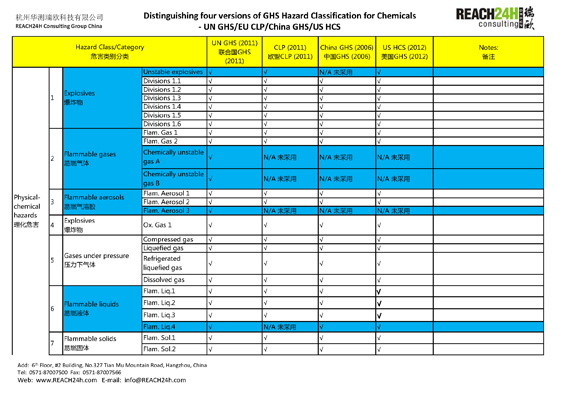GHS Classification Comparison – UN/EU/China/USA
Despite the constant development of a globally unified GHS system in recent years, slight differentiations always exist between specific countries and districts, and ignorance of this fact could always cause unexpected trouble and economic loss to your cross nation trade. Our regulatory expert in global GHS compliance, Ms. Rita Qiu would like to share a detailed diagram that helps you distinguish four GHS classification systems: UN GHS /EU CLP/China GHS/US HCS.

Compared with the 28 hazard categories defined in UN GHS and CLP, China GHS adopts only 26 categories and dismisses so far the requirements on ‘aspiration hazard’ and the ‘hazard to ozone layer’. The US HCS also designates 26 hazard classes defined under the UN GHS, laying aside the ‘hazard to aquatic environment’ and the ‘hazard to ozone layer’; furthermore, US adds 3 classes outside UN GHS – ‘Pyrophoric Gas’, ‘Simple Asphyxiant’ and ‘Combustible Dust’. Products falling within these three classes shall be classified as hazardous ones and are obliged to go together with the corresponding SDS and GHS labels.”
She also reminds clients of China New Chemical Substance Notification that, in their preparation of the Risk Assessment Report for new substances above 1 tonne/year which involves testing for hazard identification and risk control management, it’s better to check over the testing data of the related hazard classification conclusion against principles of China GHS classification. As occasionally a hazard classification conclusion may not be consistent with the due technical basis (26 China GHS GB standards) when the testing lab may apply other standards in determining the hazard positivity of a new substance. The appropriate way is to conclude the hazard identification based on actual testing data against the related GB standards. During this process, experience and knowledge of a chemical regulatory professional is unavoidable.


